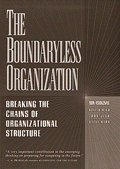"The Boundaryless Organization: Breaking the Chains of Organizational Structure" by Ron Ashkenas, Dave Ulrich, Todd Jick and Steve Kerr
The Boundaryless Organization: Breaking the Chains of Organizational Structure by Ron Ashkenas, Dave Ulrich, Todd Jick and Steve Kerr (364 pages, Jossey-Bass, 1995)
(originally published by Booz & Company) Incredibly, knowledge does sometimes evolve. Anyone who has trolled the shelves of a bookstore recently knows that leading-edge corporations of the 21st century will need to give up the command-and-control style of leadership, break down hierarchies, go virtual, embrace teamwork, encourage flexibility and so forth and so forth. The fact that there cannot be anyone left anywhere who has not heard that the old management ways are dead doesn't faze business book publishers; their authors continue preaching to the converted at great and expensive length.
Incredibly, knowledge does sometimes evolve. Anyone who has trolled the shelves of a bookstore recently knows that leading-edge corporations of the 21st century will need to give up the command-and-control style of leadership, break down hierarchies, go virtual, embrace teamwork, encourage flexibility and so forth and so forth. The fact that there cannot be anyone left anywhere who has not heard that the old management ways are dead doesn't faze business book publishers; their authors continue preaching to the converted at great and expensive length.
Happily, The Boundaryless Organization: Breaking the Chains of Organizational Structure speeds dutifully, in a breathless if-this-is-Tuesday-it must-be-re-engineering manner, through the old arguments and then proceeds on to less well-trodden ground.
The four people who put this volume —Ron Ashkenas, Dave Ulrich, Todd Jick and Steve Kerr, a mix of consultants, former academics and management trainers—offer a guide to the steps to be taken after a company decides it needs a structural overhaul. Written for the people who will actually be in charge of the change, The Boundaryless Organization is a handbook on how, not why, to create a corporate structure that mimics the borderless global marketplace everyone expects the world to become soon. The book is not an easy read—it certainly won't chase John Grisham off the bedstand and back to his law firm—but then maybe that's fair because as numerous companies have discovered, change is not an easy process.
Like many management experts, the authors are not shy about taking a broom to the advice of their brother and sister experts. They contend that most corporations, having got the message that reconfiguration is inevitable, are stumbling around, tripping over the false premises of the managerial advice they are trying to implement. Many of the change tactics embraced by corporations are rooted in a mythology about the creation of an effective structure. The most overrated techniques, according to the authors: "delayering," one of the many euphemisms for downsizing; training programs and employee empowerment. And companies tend to assume incorrectly that the vast corps of middle managers will resist change.
Some of these "myths" would seem to be virtues in a lean and mean world, but the authors argue that companies have flubbed their opportunities, putting money and time into strategies they don't truly understand, underestimating the complexity of the process they are trying to manage and misjudging the abilities and intentions of their employees. "Delayering" may flatten an organization, but flattening doesn't automatically turn a sclerotic organization into a flexible one. Training provides skills, but for what? Responsibility for decision-making seeps downward, but the authority to take action does not.
The authors believe less in toppling hierarchies than in creating "healthy hierarchies." A hierarchy may be an obstacle if it is too rigid but it can also clarify lines of communication and authority. Hierarchies in a state of nature can make life nasty, poor, brutish and short, but they can also impose the order necessary for working effectively. The goals companies should be working for—better customer relations, for example—are familiar. How a middle manager, say, should shift to thinking of customers rather than his bosses as his primary constituents is less so. The authors' advice is refreshingly practical: embark on small, realizable changes and don't get caught up in grand schemes. And, almost as if they were a group of unreconstructed Yippies caught out of context, Mr. Ashkenas and his colleagues believe in "busting" boundaries just to show it can be done.
All of this would just be platitudes-in-progress if not for the meat of the book: its self-surveys and inventories, with which team leaders, executives and others in responsible positions—i.e., on the hot seat—can hunker down and take the measure of their organizations. There are inventories for evaluating everything from team effectiveness and customer relationships to the degree of "verticality" in an organization. They may veer toward the hokey, but presumably the results inject a highly ambiguous process with some markers of objective reality.
There are a few problems with the framework. With apologies to Dr. Freud, in the "sometimes a cigar is just a cigar" category, sometimes the complexity the authors see is mere obfuscation. After half a decade of corporate "delayering," it would be a credulous consultant indeed who believes downsizing companies are doing anything fancier than lowering their costs and raising their stock prices, consequences be damned. Jack Welch, who created a boundaryless organization at General Electric by implementing an extremely tough set of management practices, is apotheosized as a visionary chief who acted with "speed, simplicity and self-confidence." 'Tis not much of a gift to be simple when you've got absolute authority and a golden parachute.
And must all companies, having gone boundaryless, go global? The authors suggest yes, but must every company want to sell soap in Sri Lanka? A company that moves into the global market with no more justification than The Boundaryless Organization asks for is a company with a lot of problems in its future.
But ultimately, the book's biggest drawback is simply that it is very dull. In other genres, romance novels, for example, such a judgment might harm a book's chances in the marketplace. Business book audiences may like a good read as much as any other, but they also seem highly tolerant of the stolid, perhaps equating it with worthiness. In the case of The Boundaryless Organization, that would be exactly the appropriate equation. ![]()




